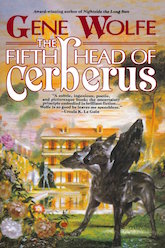The King of Hearts, not the wisest of monarchs, gives this advice on reading in Alice’s Adventures in Wonderland: “Begin at the beginning […] and go on till you come to the end: then stop.” That advice has never served Lewis Carroll’s readers, who delight in re-reading the Alice books and solving their puzzles, and it serves just as poorly for Gene Wolfe’s readers, many of whom don’t count a Wolfe book as read until it’s been re-read.
Still, whatever failings the King of Hearts might have had, there’s something to be said for beginning at the beginning, and so here follows my examination of Gene Wolfe’s opening sentences.
Buy the Book


The Knight: Book One of The Wizard Knight
Going on until you come to the end is one thing, but even beginning at the beginning can be difficult with Wolfe. Science fiction and fantasy have reputations for being self-referential; think, for example, of George R.R. Martin’s radical revision of epic fantasy, or of the summary dismissal of past utopias in William Gibson’s “The Gernsback Continuum.” Wolfe knows the genre—he’s been reading it since the forties and writing it since the sixties—and he happily admits the influence of, for example, Jack Vance’s Dying Earth books on his own New Sun sequence.
A knowledge of SFF, even one as deep as Wolfe’s, is rare but not unexpected; I’m not sure that it’s as fundamental to Wolfe’s success as his broad knowledge of literature in general. He shares with his sometime collaborator Neil Gaiman an appreciation of early twentieth-century titans like Chesterton and Kipling; he’s also an enthusiastic reader of Nabokov, Proust, and quintessential postmodernist Robert Coover. The opening line of The Fifth Head of Cerberus, “When I was a boy my brother David and I had to go to bed early whether we were sleepy or not,” is a riff on Proust’s “For a long time I went to bed early.” Readers unfamiliar with Swann’s Way will enjoy and understand the story, while people who recognize the source quote will be unsurprised to find that The Fifth Head of Cerberus proves to be a story of reminiscence and the decipherment of society. There’s also, perhaps, a slight clue to the story in the sentence’s grammar: If the narrator had only one brother, we would read “my brother, David” rather than the comma-less “my brother David.” We eventually do learn why that comma is missing.
Although I’ve limited myself to Wolfe’s opening sentences for the purposes of this article, he never exhausts his effects on the first page. To pick an example at random: a single sentence in the first person near the very end of a book otherwise in the third person asks readers to reconsider everything that they’ve already read. Learning that the narrator is a participant in the tale, albeit a relatively insignificant one, both explains a lot and raises a whole series of new questions.
Buy the Book


The Fifth Head of Cerberus
I’ve talked about three of Wolfe’s opening sentences here; if you consider the novels alone and disregard the hundred-plus short stories, there are still more than thirty openings to consider. Wolfe is prolific, and more than one friend has asked me where to start reading him. I maintain that The Book of the New Sun remains the best place to start with Wolfe, since I believe it’s both his masterpiece and a pinnacle of the genre. It’s a strange and paradoxical book: a ruminative picaresque, a dirge of rebirth, set in a world that’s equally of the future and of the past. It’s also a thousand pages and four books long, so you may want to start elsewhere.
Readers who, King of Hearts-like, want to begin at the beginning of Wolfe’s career should ignore his first novel, Operation ARES, disowned long ago and for decades absent even from the “Also by Gene Wolfe” page at the front of his books, and instead read his second, the much-superior The Fifth Head of Cerberus, which is perhaps the best one-book introduction to his work. Wolfe has many standalone titles, but some of his mid-career books, like Castleview and Pandora by Holly Hollander, are very atypical, and some of his later books, straightforward and even terse as they may seem, are among the most oblique and complicated of his career, and as such not the best place to start. Pirate Freedom is a relatively recent book and a comparatively straightforward one; I wouldn’t rank it as his best, though it’s among his most accessible and includes, should you ever need them, useful pointers on surviving a knife fight. The Devil in a Forest is another comparatively simple book, about growing up and the glamor of evil. Peace is a short and apparently realistic novel; it’s one of Wolfe’s best, though very quiet and subtle, and would be my immediate recommendation for someone who doesn’t read much genre fiction.
In any case: Begin at the beginning and go on till you come to the end: then start again, or start another.
Matt Keeley reads too much and watches too many movies; he is helped in the former by his day job in the publishing industry. You can find him on Twitter at @mattkeeley.










